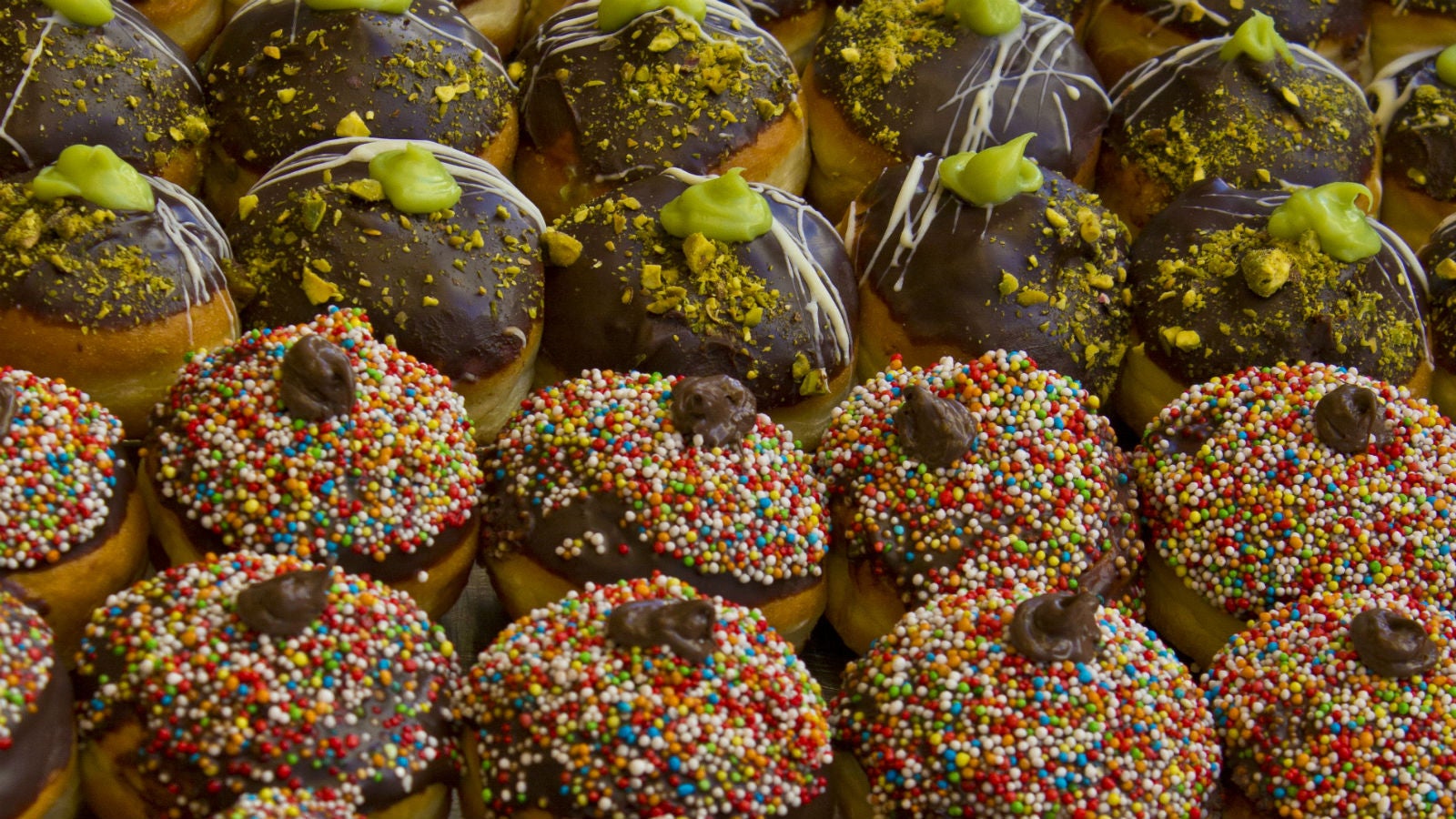Israelis don’t make a fuss about latkes on Hanukkah. They’re something you may eat at your grandmother’s house — always homemade, a one-time event, and not associated with a specific accompaniment (the applesauce vs. sour cream debate isn’t a thing).
But donuts, or as they’re more commonly known, sufganiyot, are another story. They’re the undisputed edible highlight of the holiday.
Typically, Israelis don’t make sufganiyot at home; they pick them up at their local bakery. And in the past decade, sufganiyot have become a nationwide trend. Each bakery attempts to outdo one another with crazy flavor combinations and eye-catching designs, showcasing them in their windows as early as the end of October.
Sufganiyot aren’t just donuts — they’re extra, larger-than-life, and the definition of more is more.
The Nosher celebrates the traditions and recipes that have brought Jews together for centuries. Donate today to keep The Nosher's stories and recipes accessible to all.
At the Nosher, we love a food trend, particularly one as extra as this. So I decided to delve into the past, present, and future of the Israeli sufganiya.
Who decided we should eat donuts on Hanukkah?
This tradition has some serious roots. Some argue that “sufganiya” is linked to the word “sfenj,” a deep-fried ball of dough popular in North African Jewish communities, who continue to eat sugar-coated sfenj at Hanukkah. Sfenj are a common feature of modern Israeli food markets, though for the best tasting morsels, befriend a Moroccan grandmother with a need to feed.
Filled donuts, however, were brought to Israel by Central and Eastern European immigrants. According to Jewish food historian Gil Marks, Polish Jews began eating jelly-filled donuts at Hanukkah when sugar prices (previously a luxury for the rich) fell in the 1500s. They called them ponchiks, and filled them with plum, raspberry, or rose-petal jelly. They continued the tradition after immigrating to Israel in the late 1800s.
Donut fact!
The first recorded recipe for a jelly donut predates ponchicks by almost 300 years. It was featured in a German cookbook and involved filling two round slices of bread with jelly, then deep-frying it in lard. Perhaps it’s because I’m pregnant, but a schmaltz-fried version with a cranberry jelly or, better yet, chili jam filling sounds kind of appealing.
Time for a comeback?
When did sufganiyot actually become a thing?
This is where it gets weirdly political: In 1920, the Histradut (the national Labor Federation with Russian socialist principals that included advocating for full-time employment) sought a solution to the post-High Holiday lull that rendered many Jewish workers unemployed. Although latkes were a common Hanukkah food, they were too easy to make at home. Filled donuts, on the other hand, required more skill, and provided a perfect employment solution for Austrian and Hungarian immigrants, who were already familiar with jelly donuts.
So the Histradut set out on a (highly successful) campaign to ensure that these sticky, fried treats became an indispensable part of Israel’s Hanukkah celebrations. Those evil geniuses!
But when did sufganiyot become a trend?
Israelis have always been open to food influences introduced by various immigrant groups. For the past 20 years, for instance, alongside the classic jelly donut, you’ll usually find a dulce de leche version — filled with a thick caramel that was brought over by South American immigrants who were basically weaned on the stuff. With the more recent influx of French immigrants, custard fillings are becoming increasingly popular.
The bakery behind the wild and wonderful sufganiya trend, though, is Roladin. While it’s unclear if they thought it up themselves, their nationwide presence and excellent marketing proved extremely successful, and they continue to lead the craziness each year. Over half their sales are yearly specials, as opposed to classic flavors.
Hipster Tel Aviv is the natural hub of bonkers sufganiyot. Recent years have seen everything from Bazooka bubblegum-inspired treats to tiramisu, cereal and milk, and matcha-white chocolate featured at Biscotti, Piece of Cake, and The Showroom Bakehouse bakeries, to name a few.
Just how far this trend can go and if there’s a limit to the madness remains to be seen. I say enjoy it while it lasts; if you were looking for a sign to book a last-minute trip to Israel: this is it.
Staying home for the holidays? There’s no need to miss out. Try your hand at these chocolate babka donuts or all-American PB&J.



